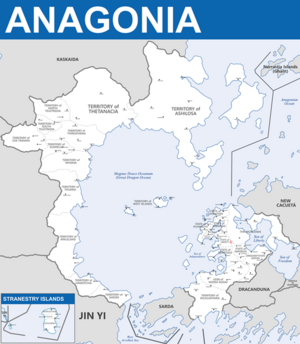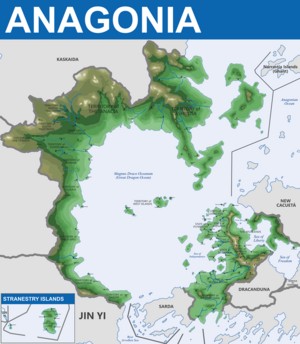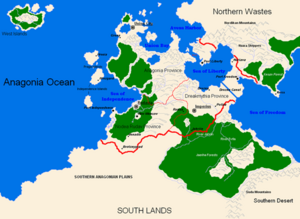Anagonia
This article is incomplete because it is pending further input from participants, or it is a work-in-progress by one author. Please comment on this article's talk page to share your input, comments and questions. Note: To contribute to this article, you may need to seek help from the author(s) of this page. |
The Confederate States of Anagonia Anagonia | |
|---|---|
| Motto: "Astra inclinant, sed nonobligant" (The stars incline, but do not oblige) | |
| Anthem: "My Country! 'Tis Of Thee" (Adopted July 14th, 104 AUR by Grand Congress vote) | |
 | |
| Capital | Liberty City |
| Largest city | Atlantica |
| Official languages | Native Anagonian & English |
| Recognised regional languages | Regional dialects dependent on State or Territory |
| Other languages | (Other European, Russian, Spanish, Other Asian, Various Non-Human Languages) |
| Ethnic groups (As of 108 AUR) | Anagonian (Primary) Various other ethnic groupings depending on state and territory |
| Demonym(s) | Anagonian(s), Confederate(s) |
| Government | Confederal Presidential Republic |
• President | Mileethus Canisilus |
• Vice President | Franklin Johnson |
| Establishment | |
• Commonwealth of Mal-Videnus (1st iteration) | 110 BCE - 20 BCE |
• Republic of Anagonia | 23 CE - 24 CE |
• Commonwealth of Mal-Videnus (2nd iteration) | 24 CE - 925 CE |
• Kingdom of Anagonia | 1100 CE - 1360 CE |
• Free Republic of Anagonia | 1275 CE - 1361 CE |
• United Republic of Anagonia | 1361 CE - 1921 CE |
• Confederate States of Anagonia | 1921 CE - Present |
| Area | |
• Total | 21,864,400 km2 (8,441,900 sq mi) |
| Population | |
• 108 AUR estimate | 450,522,407 |
• Density | 5.77/km2 (14.9/sq mi) |
| GDP (nominal) | 108 AUR estimate |
• Total | D$28,424,257,741,025 |
• Per capita | D$78,246.01 |
| Gini | 0.43 low |
| HDI | 0.927 very high |
| Currency | Confederate DENAR (D$) |
| Time zone | UTC+5 (Anagonian Standard Time Zones) |
• Summer (DST) | UTC+6 (Anagonian Standard Time Zones) |
| Driving side | right |
| Calling code | 678 |
| Internet TLD | .CSA |
The Confederate States of Anagonia has:
| |
Introduction
Anagonia, officially the Confederate States of Anagonia, is a large nation that exists within the region of Esvanovia renowned for its rich cultural heritage, diverse landscapes, and vibrant biodiversity which includes non-human sapient life. Situated around the heart of the Anagonian Ocean and on two continential landmasses, Anagonia spans approximately 21,864,400 square kilometers, encompassing a primary territorial claim which surrounds the majestic Magnus Draco Oceanum, also known as the Great Dragon Ocean. The nation's territory is divided between the continents of Minor Kistavich, where the mainland is located, and Major Kistavich, which hosts the rest of the Territories across the Great Dragon Ocean.
Home to seven states—Lexington, Plymouth, Arkansis, Orgath, Liberty, Saratoga, and Imperius—and sixteen territories—West Islands, Wildlands, Ashilosa, Thetanacia, North Teustredia, South Teustredia, Thireatheria, Che Traman, Duderlia, Whiana, Thuaria, Arkleland, Hamotichia, Sarder, Wildlantaria, and the Stranestry Islands—Anagonia boasts a rich tapestry of cultural traditions and historical significance. Each state and territory contributes to the nation's unique identity, with distinct landmarks, festivals, and customs that reflect its heritage. Several non-human semi-sapient wildlife and non-human sapient citizens call these lands and territories home.
With its captivating scenery, fascinating wildlife and citizenry, and vibrant communities, Anagonia as a whole is a land of endless exploration and discovery which draws in visitors from far and wide to experience its wonders firsthand.
History
Etymology
The etymology of "Anagonia" intertwines with the ancient history and cultural tapestry of the land, reflecting the diverse influences that have shaped its meaning over time. At the heart of this etymology lies the intersection of two distinct cultures: the Seurians, akin to the Anglo-Saxons, and the indigenous Anagonians.
Historians, archeologists, and etymologists all agree that the native language of modern Anagonians and their unique name must derive from some experience with the Seurians prior to 6967 BCE.
Around 400 BCE, it was historically recorded both in ancient texts and archeological findings that Ancient Seuria, the ancient homeland of the Seurians on the continent of Major Kistavich, waged a violent war against the Anagonian people and her neighbors under the leadership of the Ancient Seurian known as "Oisean Macmathan". Rikor Hak, the well-known Second Disciple of Melkos, has well preserved journals and written texts on his and his armies experiences in fending off the "Seurian Empire".
It is through these journals, texts, and recorded historical events that etymologists have been able to conclude that Seuria played a heavy role in Anagonian language syntax and development. Seuria, which in modern day exists as a diminished island nation north of nations of Arcadie and Kaskaida and resides in the Northern Ocean, has had long-lasting cultural, linguistic, and other influences on Anagonian culture.
The supposed prefix "Ana-" and suffix "-gonia" further enrich the meaning of "Anagonia." The prefix "Ana-" could potentially denote a sense of primordial or native essence, suggesting an origin deeply rooted in the land itself. Meanwhile, the suffix "-gonia" commonly denotes a land or territory, implying that Anagonia is not just a place but a distinct realm imbued with its own unique character and significance. Together, these linguistic elements encapsulate the essence of Anagonia as a land of ancient heritage, mythical connections, and enduring legacy.
The name "Anagonia" carries echoes of both Seurian and Anagonian heritage. Through meticulous research and lore, it has been deciphered to translate as "Native Dragon Man," offering insight into the ancestral relationship between the Anagonians and the mythical dragons that roamed their land. This interpretation suggests a profound connection between the indigenous people and the awe-inspiring creatures that inhabited their midst. It also supposed that perhaps at one point, the word "Anagonia" could have used by Seurians as an identifier to what an Anagonian could have been before their name.
The term "Dragon Man" within the context of Anagonia evokes images of a society intertwined with the mythos of dragons, perhaps revered as guardians or spiritual beings. It speaks to a time when dragons may have played a significant role in the lives and legends of the Anagonian people, shaping their culture, beliefs, and even their very identity. Thus, "Anagonia" serves as a testament to the enduring bond between Anagonia and the mystical realm of dragons, a bond woven deep into the fabric of Anagonian history and lore, and a bond that persist to Modern Day as Anagonians continue pilgrimages to see their dragon kin.
Geography and Climate
Anagonia, a vast and diverse nation spanning approximately 21,864,400 square kilometers, boasts a varied landscape characterized by rugged mountains, sweeping plains, and coastal regions. With its mainland and capital situated southeast of the heart of the Anagonian Ocean, the nation itself encompasses and surrounds the magnificent Magnus Draco Oceanum, also known as the Great Dragon Ocean, which serves as the centerpiece of the nation's geography via its vast expanse.
Geography

Image circa 108 AUR
NOTE POST-GREAT WAR CHANGES:
* More Territory to Southwest of Mainland
* Annexation of Additional Islands
* Annexation of Conquered Kaskaida Territories
Anagonia's mainland is delineated by the continents of Minor Kistavich and Major Kistavich, with the Great Dragon Ocean occupying the central expanse. The northern territories, including Ashilosa, Thetanacia, North Teustredia, South Teustredia, and Thireatheria, are dominated by mountainous terrain that gradually slopes downward into steppes, grasslands, and marshlands as they approach the Great Dragon Ocean. To the west, the Territories of Che Traman, Duderlia, Whiana, Thuaria, Arkleland, Hamotichia, and Sarder feature similar mountainous landscapes that give way to coastal plains along the shores of the Great Dragon Ocean.
In the western reaches of the nation lie the remnants of a sunken continent, now known as the West Islands, serving as a testament to ancient geological upheavals. The Stranestry Islands, located south of the Territory of Sarder in the West Arvolken Sea, offer a contrasting landscape with their gentle slopes and favorable weather conditions. To the east, mainland Anagonia transitions from the independent nation of Sarda to the Sovereign Nation of Nodea Rudav and the Imperial Drekamythian Empire, culminating in the peninsula-like mass of Anagonia proper.
The mainland of Anagonia, which is situated southeast of the Great Dragon Ocean on the continent of Minor Kistavich, is further divided into seven states: Lexington, Plymouth, Orgath, Liberty, Saratoga, Imperius, and Arkansis. The State of Saratoga and the State of Plymouth lay claim to three large islands in the Sea of Independence, providing strategic access to the Great Dragon Ocean.

(circa United Republic era - 1921 AD & prior)
NOTE THE THREE DISTINCT PROVINCES:
* Anagonia Province
* Drekamythia Province
* Nodea Rudav Province
The United Republic of Anagonia was a more federalized entity that combined the mainland Anagonia into one primary nation. It would eventually fall due to civil war in 1921 AD.
Climate
Anagonia experiences a diverse range of climates due to its expansive geography and varied topography. The northern territories are characterized by a continental climate, with cold winters and warm summers, while the coastal regions benefit from milder temperatures moderated by oceanic influences.
In the mountainous regions, precipitation is abundant, resulting in lush forests and verdant valleys. The western territories receive ample rainfall, fostering fertile soils ideal for agriculture and supporting diverse ecosystems. In contrast, the eastern reaches of Anagonia, bordering the Imperial Drekamythian Empire and the Sovereign Nation of Nodea Rudav, experience somewhat drier conditions, with semi-arid climates prevailing in some areas. However this is diversified within the mainland of Anagonia in its primary states. They experiences a wide verity of temperate-to-dry conditions year-round which support a wide variety of agricultural and biological diversity, with mild winters typically thanks to warmer currents flowing from the north.
The coastal regions, including the Territories of Che Traman, Duderlia, Whiana, Thuaria, Arkleland, Hamotchia, and Sarder, enjoy mostly temperate climates characterized by mild winters and moderate summers. The Stranestry Islands boast favorable weather conditions year-round, making them popular destinations for tourists and travelers seeking relaxation and tranquility.
Overall, Anagonia's climate and geography contribute to its rich biodiversity and cultural diversity, making it a land of endless exploration and discovery.
Biodiversity
Government
Executive government
| Chief of State | Time in Office | Head of Government | Time in Office |
|---|---|---|---|
| President Mileethus Canisilus | 105 AUR - Current | President Mileethus Canisilus | 105 AUR - Current |
| Vice President Franklin Johnson | 105 AUR - Current | Vice President Franklin Johnson | 105 AUR - Current |
Elaboration on the Executive Branch Structure
The Executive Branch consists of Departments of the President and Vice-President presiding at the top and overseeing all departments underneath them, within constitutional limits. The Department of the President is primarily responsible with the formation of new departments as well as restructuring of any department within their authority. Since the governance of the 8th President of the Confederate States, President Rudolf Jarod Hart (55 AUR - 60 AUR), the Executive Branch has consisted of two levels of Cabinet Departments.
The first level of Cabinets, the Senior Cabinet, consists of Departments with multiple roles and considered extremely essential to the functioning of proper government and support to and for the Departments of the President and Vice President. The Senior Cabinet generally consists of one singular Department which consists of several roles. Some of the Senior Cabinets also oversee the Junior Cabinet Departments.
The second level of Cabinets, the Junior Cabinet, consists of Departments with singular roles and objectives and thereby are considered not generally essential to the functioning of proper government, with the exception of CASA due to national security importance. Generally the heads of these singular Cabinet Departments report to superiors in the Senior Cabinet, with the primary objective of supporting the Senior Cabinet in the functioning of everyday governance and national security.
The only exception to the rule of governance for both Senior and Junior Cabinets is that of Cabinet Departments headed by military officials. These departments are primarily governed by the authorities of the Articles of the Armed Forces of the Confederacy, and while they operate traditionally under the authority of the President, they may be sequestered by a reigning military official - elected by Joint Assembly of Chiefs and Commanding Officers - in times of national emergency.
Senior Cabinet
The Senior Cabinet is appointed by President with Grand Congressional Approval. Exceptions are Military Cabinets which may be appointed by vote of Joint Military Assembly in times of crisis. Senior Cabinet consists of major essential government positions. Typically, all Senior Cabinet Departments operate with a specific objective, but some Departments also lead Junior Cabinet Departments as overseeing administrators.
| Senior Department | Appointed Staff | Acronymn | Notes |
|---|---|---|---|
| Department of the Confederate States | Chief Secretary Forest Patton | (DCS) | (Includes Departments of Domestic and Foreign Relations and Diplomatic Affairs) |
| Department of National Defense | Chief General Maximus Leddicus (Komodren; CSMC) | (DND) | (Includes Departments of National Intelligence, Nuclear Arms, Military Development, Homeland Security, and Space Affairs. Number Three on the Military Chain of Command) |
| Constitutional Office of Justice | Chief Justice Karl Roberts | (COJ) | (Supreme Court of the Confederacy) |
| Council of the States | Chief General Robert Chin (CSAF) | (COTS) | (Departments of the Interior, Health and Citizen Services, Housing and Urban Development, and Education) |
| Chief General of the Confederate States Armed Forces | Chief General Maximus Leddicus (Komodren; CSMC) | N/A | (Vice Commander in Chief of all Armed Forces. Number Two on the Military Chain of Command) |
| Chief of the Confederate Congress | Chief Senator Wyatt Alexander | N/A | (Representative Leader of the Grand House and Grand Senate, usually chosen from the Grand Senate of the Confederacy) |
| Council of States Agriculture | Chief Secretary Alma Hunter | (COSA) | (Departments of Agriculture, Energy, and Trade) |
| Council of Confederate Commerce | Chief Secretary Hillary Kim | (COCC) | (Departments of the Treasury, Large and Small Business Advancement, and Economic Advancement) |
| Confederate States Joint Department of Progress | Chief Admiral Dave Evans (CSN) | (CSJDP) | (Departments of National Development, Labor, Scientific Advancement, and Veterans Affairs) |
Junior Cabinet
The Junior Cabinet can be appointed by President with Grand Congressional Approval, though typically with the possibility of sole Grand Congressional appointment. The only exceptions include the Military Cabinets which may be appointed by vote of Joint Military Assembly in times of crisis. The Junior Cabinet consists of minor essential government positions which serve under the Senior Cabinet. This list is commonly known as the "alphabet cabinet" to those in the Confederate Government.
| Junior Department | Appointed Staff | Acronymn | Notes |
|---|---|---|---|
| Vice-Chief of the Confederate Congress | Grand Representative Photios Nicoloulis (Kroman) | N/A | (Vice-Representative Leader of the Grand House and Grand Senate, usually chosen from the Grand House of Confederate Representatives) |
| Confederate States Department of Colonial Affairs | Chief Secretary Rodger Williams | (CSDCA) | (Handles affairs and representation for territories and over-seas land claims) |
| Confederate National Intelligence Agency | Major General Lucias Zoilus (Komodren, CSMP) | (CNIA) | (Department for extra-national intelligence operations, primarily. Assist with domestic threat issues) |
| Confederate National Bureau of Investigation | Director Daron McKnight & Lieutenant General Darrel Osborne (CSMP) | (CNBI) | (Department for internal intelligence operations, assisting with domestic civil protection, and assisting with upholding law and government accountability) |
| Confederate Aeronautics and Space Administration | Chief Administrator Marissa Schultz | (CASA) | (National Space Agency handling space operations on behalf of the government and people; supports private industry space operations) |
| Department of the Advancement of Confederate Military Superiority | Commodore Lartia Aeaca (Kroman, CSN) | (DACMS) | (Department for the advancement of military technology and top-secret projects) |
| Confederate National Department of Transportation | Chief Secretary Caitlin Blackwell | (CNDOT) | (National Department for Infrastructure Construction, Maintenance, and Repair) |
| Confederate Environmental Protection Agency | Chief Administrator Otha Sosansan | (CEPA) | (National Department for the stewardship of the nations environment, enforcing environmental policies, and ensuring industry compliance) |
| Confederate National Department of Homeland Security | Brigadier General Adrian Santiago (CSMC) | (CNDHS) | (National Department to assist with civil and military protection duties, both internal and external, as well as light surveillance, intelligence, and judicial operations) |


